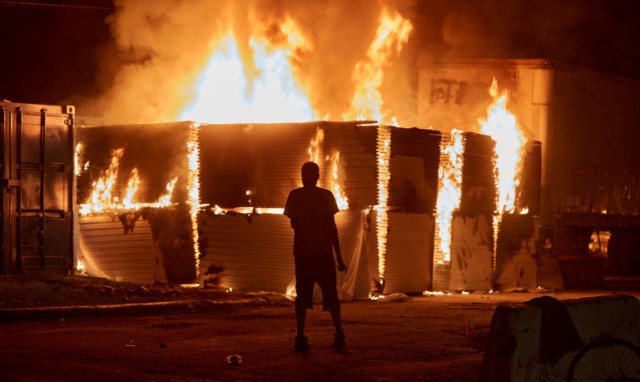Protests expanded in a number of US states denouncing police practices after the killing of George Florid by a policeman in the city of Minneapolis, at a time when Minnesota announced public mobilization of its National Guard to confront the violence, and President Donald Trump waved deployment of the military quickly to counter the protests.
In addition to Minneapolis, the capital of Minnesota, demonstrations took place in the cities of New York, Atlanta, Portland, Washington, Los Angeles, Oakland and Detroit, and in some cities bloody confrontations occurred between the police and protesters over the security authorities' dealings with minorities, particularly of African descent.
American media reported that two people, one of them a police officer, were killed during the protests in Oakland, California, while another was injured in a shooting attack on a building belonging to the federal government.
In Detroit, Michigan, a young man was shot and killed by unknown source while participating in the demonstrations, where one of them shot him from a car and then fled.
Attacks
in Atlanta and in Atlanta, Georgia, protesters attacked the headquarters of the CNN news station, and police cars were attacked, angering the city's mayor, Kaisha Lance Bottom, who said, "You are misjudging this city, the life of George Floyd, and everyone who was unjustly killed in this country." .
In Los Angeles, western America, protesters echoed George Floyd's latest words, appealing to the policeman to breathe, while thousands of protesters took to the streets of the Brooklyn area in New York, and police used batons and pepper spray to arrest dozens of protesters during clashes between the two sides.
In Washington, DC, police and Secret Service officers deployed heavily around the White House before dozens of protesters gathered across the street from Lafayette Square.
Mobilization
in Minnesota In Minnesota, whose authorities imposed a curfew yesterday, its governor, Tim Wallis, ordered the general mobilization of the National Guard, for the first time since World War II to help restore security and control after four nights of clashes in Minneapolis between police and protesters.
About 1,700 National Guard personnel were deployed in Minneapolis, and the state governor said demonstrations and violence in the state were no longer linked to Floyd’s killing, describing it as utter chaos.
Demonstrations erupted in the city yesterday for the fourth night in a row, although prosecutors announced Friday the arrest of policeman Derek Chauven, who appeared in a video recording his knee on Floyd's neck, for third-degree murder and manslaughter.
The authorities dismissed the policeman and three of his colleagues who participated in the incident, and they are currently being investigated in connection with the incident, which sparked anger that civil rights activists say has been raging for a long time in Minneapolis and a number of cities across the country because of the ongoing racial bias in the American criminal justice system .
Military alert
The Associated Press of America quoted sources as saying that the Pentagon has ordered the military to put military police units on high alert to intervene in the city as quickly as possible, at the request of President Trump.
The US President said today that he might order the army to crack down on anti-police demonstrations, calling on state and city authorities to more aggressively confront protests, or make room for federal authorities to intervene, including using the military.
It is noteworthy that the United States has witnessed in recent years many incidents of killing African citizens by the police, which sparked protests against the mistreatment of this minority by the authorities.

